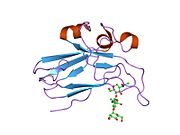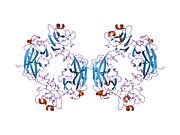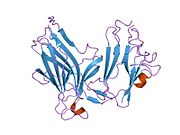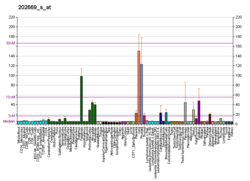Ephrin B2
| EFNB2 | |||||||||||||||||||||||||||||||||||||||||||||||||||
|---|---|---|---|---|---|---|---|---|---|---|---|---|---|---|---|---|---|---|---|---|---|---|---|---|---|---|---|---|---|---|---|---|---|---|---|---|---|---|---|---|---|---|---|---|---|---|---|---|---|---|---|
 | |||||||||||||||||||||||||||||||||||||||||||||||||||
| |||||||||||||||||||||||||||||||||||||||||||||||||||
| Identifiers | |||||||||||||||||||||||||||||||||||||||||||||||||||
| Aliases | EFNB2, EPLG5, HTKL, Htk-L, LERK5, ephrin B2 | ||||||||||||||||||||||||||||||||||||||||||||||||||
| External IDs | OMIM: 600527; MGI: 105097; HomoloGene: 3019; GeneCards: EFNB2; OMA:EFNB2 - orthologs | ||||||||||||||||||||||||||||||||||||||||||||||||||
| |||||||||||||||||||||||||||||||||||||||||||||||||||
| |||||||||||||||||||||||||||||||||||||||||||||||||||
| |||||||||||||||||||||||||||||||||||||||||||||||||||
| |||||||||||||||||||||||||||||||||||||||||||||||||||
| |||||||||||||||||||||||||||||||||||||||||||||||||||
| Wikidata | |||||||||||||||||||||||||||||||||||||||||||||||||||
| |||||||||||||||||||||||||||||||||||||||||||||||||||
Ephrin-B2 is a protein that in humans is encoded by the EFNB2 gene.[5]
Function
This gene encodes a member of the ephrin (EPH) family. The ephrins and EPH-related receptors comprise the largest subfamily of receptor protein-tyrosine kinases and have been implicated in mediating developmental events, especially in the nervous system and in erythropoiesis. Based on their structures and sequence relationships, ephrins are divided into the ephrin-A (EFNA) class, which are anchored to the membrane by a glycosylphosphatidylinositol linkage, and the ephrin-B (EFNB) class, which are transmembrane proteins. This gene encodes an EFNB class ephrin which binds to the EPHB4 and EPHA3 receptors.[6]
Cancer
EFNB2 gene has been observed progressively downregulated in Human papillomavirus-positive neoplastic keratinocytes derived from uterine cervical preneoplastic lesions at different levels of malignancy.[7] For this reason, EFNB2 is likely to be associated with tumorigenesis and may be a potential prognostic marker for uterine cervical preneoplastic lesions progression.[7]
Interactions
EFNB2 has been shown to interact with EPHA3[8][9] and EPHB1 in optic chiasm development.[10]
EFNB2 has also been shown to serve as a receptor for Hendra Virus and Nipah Virus, mediating entry into the cell during infection.[11]
References
- ^ a b c GRCh38: Ensembl release 89: ENSG00000125266 – Ensembl, May 2017
- ^ a b c GRCm38: Ensembl release 89: ENSMUSG00000001300 – Ensembl, May 2017
- ^ "Human PubMed Reference:". National Center for Biotechnology Information, U.S. National Library of Medicine.
- ^ "Mouse PubMed Reference:". National Center for Biotechnology Information, U.S. National Library of Medicine.
- ^ Bonaldo MF, Yu MT, Jelenc P, Brown S, Su L, Lawton L, Deaven L, Efstratiadis A, Warburton D, Soares MB (Sep 1994). "Selection of cDNAs using chromosome-specific genomic clones: application to human chromosome 13". Human Molecular Genetics. 3 (9): 1663–73. doi:10.1093/hmg/3.9.1663. PMID 7833926.
- ^ "Entrez Gene: EFNB2 ephrin-B2".
- ^ a b Rotondo JC, Bosi S, Bassi C, Ferracin M, Lanza G, Gafà R, Magri E, Selvatici R, Torresani S, Marci R, Garutti P, Negrini M, Tognon M, Martini F (April 2015). "Gene expression changes in progression of cervical neoplasia revealed by microarray analysis of cervical neoplastic keratinocytes". J Cell Physiol. 230 (4): 802–812. doi:10.1002/jcp.24808. hdl:11392/2066612. PMID 25205602. S2CID 24986454.
- ^ Cerretti DP, Vanden Bos T, Nelson N, Kozlosky CJ, Reddy P, Maraskovsky E, Park LS, Lyman SD, Copeland NG, Gilbert DJ (Nov 1995). "Isolation of LERK-5: a ligand of the eph-related receptor tyrosine kinases". Molecular Immunology. 32 (16): 1197–205. doi:10.1016/0161-5890(95)00108-5. PMID 8559144.
- ^ Lackmann M, Mann RJ, Kravets L, Smith FM, Bucci TA, Maxwell KF, Howlett GJ, Olsson JE, Vanden Bos T, Cerretti DP, Boyd AW (Jun 1997). "Ligand for EPH-related kinase (LERK) 7 is the preferred high affinity ligand for the HEK receptor". The Journal of Biological Chemistry. 272 (26): 16521–30. doi:10.1074/jbc.272.26.16521. PMID 9195962.
- ^ Williams SE, Mann F, Erskine L, Sakurai T, Wei S, Rossi DJ, Gale NW, Holt CE, Mason CA, Henkemeyer M (September 2003). "Ephrin-B2 and EphB1 mediate retinal axon divergence at the optic chiasm". Neuron. 39 (6): 919–35. doi:10.1016/j.neuron.2003.08.017. PMID 12971893.
- ^ Bonaparte MI, Dimitrov AS, Bossart KN, Crameri G, Mungall BA, Bishop KA, Choudhry V, Dimitrov DS, Wang LF, Eaton BT, Broder CC (July 2005). "Ephrin-B2 ligand is a functional receptor for Hendra virus and Nipah virus". Proceedings of the National Academy of Sciences of the United States of America. 102 (30): 10652–7. Bibcode:2005PNAS..10210652B. doi:10.1073/pnas.0504887102. PMC 1169237. PMID 15998730.
Further reading
- Flanagan JG, Vanderhaeghen P (1998). "The ephrins and Eph receptors in neural development". Annual Review of Neuroscience. 21: 309–45. doi:10.1146/annurev.neuro.21.1.309. PMID 9530499.
- Zhou R (Mar 1998). "The Eph family receptors and ligands". Pharmacology & Therapeutics. 77 (3): 151–81. doi:10.1016/S0163-7258(97)00112-5. PMID 9576626.
- Holder N, Klein R (May 1999). "Eph receptors and ephrins: effectors of morphogenesis". Development. 126 (10): 2033–44. doi:10.1242/dev.126.10.2033. PMID 10207129.
- Wilkinson DG (2000). "Eph receptors and ephrins: regulators of guidance and assembly". International Review of Cytology. 196: 177–244. doi:10.1016/S0074-7696(00)96005-4. ISBN 9780123646002. PMID 10730216.
- Xu Q, Mellitzer G, Wilkinson DG (Jul 2000). "Roles of Eph receptors and ephrins in segmental patterning". Philosophical Transactions of the Royal Society of London. Series B, Biological Sciences. 355 (1399): 993–1002. doi:10.1098/rstb.2000.0635. PMC 1692797. PMID 11128993.
- Wilkinson DG (Mar 2001). "Multiple roles of EPH receptors and ephrins in neural development". Nature Reviews. Neuroscience. 2 (3): 155–64. doi:10.1038/35058515. PMID 11256076. S2CID 205014301.
- Bennett BD, Zeigler FC, Gu Q, Fendly B, Goddard AD, Gillett N, Matthews W (Mar 1995). "Molecular cloning of a ligand for the EPH-related receptor protein-tyrosine kinase Htk". Proceedings of the National Academy of Sciences of the United States of America. 92 (6): 1866–70. Bibcode:1995PNAS...92.1866B. doi:10.1073/pnas.92.6.1866. PMC 42383. PMID 7534404.
- Cerretti DP, Vanden Bos T, Nelson N, Kozlosky CJ, Reddy P, Maraskovsky E, Park LS, Lyman SD, Copeland NG, Gilbert DJ (Nov 1995). "Isolation of LERK-5: a ligand of the eph-related receptor tyrosine kinases". Molecular Immunology. 32 (16): 1197–205. doi:10.1016/0161-5890(95)00108-5. PMID 8559144.
- Cerretti DP, Lyman SD, Kozlosky CJ, Copeland NG, Gilbert DJ, Jenkins NA, Valentine V, Kirstein MN, Shapiro DN, Morris SW (Apr 1996). "The genes encoding the eph-related receptor tyrosine kinase ligands LERK-1 (EPLG1, Epl1), LERK-3 (EPLG3, Epl3), and LERK-4 (EPLG4, Epl4) are clustered on human chromosome 1 and mouse chromosome 3". Genomics. 33 (2): 277–82. doi:10.1006/geno.1996.0192. PMID 8660976.
- Gale NW, Holland SJ, Valenzuela DM, Flenniken A, Pan L, Ryan TE, Henkemeyer M, Strebhardt K, Hirai H, Wilkinson DG, Pawson T, Davis S, Yancopoulos GD (Jul 1996). "Eph receptors and ligands comprise two major specificity subclasses and are reciprocally compartmentalized during embryogenesis". Neuron. 17 (1): 9–19. doi:10.1016/S0896-6273(00)80276-7. PMID 8755474.
- Holland SJ, Gale NW, Mbamalu G, Yancopoulos GD, Henkemeyer M, Pawson T (Oct 1996). "Bidirectional signalling through the EPH-family receptor Nuk and its transmembrane ligands". Nature. 383 (6602): 722–5. Bibcode:1996Natur.383..722H. doi:10.1038/383722a0. hdl:1807/9444. PMID 8878483. S2CID 4349898.
- Ephnomenclaturecommittee (Aug 1997). "Unified nomenclature for Eph family receptors and their ligands, the ephrins. Eph Nomenclature Committee". Cell. 90 (3): 403–4. doi:10.1016/S0092-8674(00)80500-0. PMID 9267020.
- Vogt T, Stolz W, Welsh J, Jung B, Kerbel RS, Kobayashi H, Landthaler M, McClelland M (Mar 1998). "Overexpression of Lerk-5/Eplg5 messenger RNA: a novel marker for increased tumorigenicity and metastatic potential in human malignant melanomas". Clinical Cancer Research. 4 (3): 791–7. PMID 9533549.
- Wang HU, Chen ZF, Anderson DJ (May 1998). "Molecular distinction and angiogenic interaction between embryonic arteries and veins revealed by ephrin-B2 and its receptor Eph-B4". Cell. 93 (5): 741–53. doi:10.1016/S0092-8674(00)81436-1. PMID 9630219.
- Nikolova Z, Djonov V, Zuercher G, Andres AC, Ziemiecki A (Sep 1998). "Cell-type specific and estrogen dependent expression of the receptor tyrosine kinase EphB4 and its ligand ephrin-B2 during mammary gland morphogenesis". Journal of Cell Science. 111 (18): 2741–51. doi:10.1242/jcs.111.18.2741. PMID 9718367.
- Torres R, Firestein BL, Dong H, Staudinger J, Olson EN, Huganir RL, Bredt DS, Gale NW, Yancopoulos GD (Dec 1998). "PDZ proteins bind, cluster, and synaptically colocalize with Eph receptors and their ephrin ligands". Neuron. 21 (6): 1453–63. doi:10.1016/S0896-6273(00)80663-7. PMID 9883737.
- Lin D, Gish GD, Songyang Z, Pawson T (Feb 1999). "The carboxyl terminus of B class ephrins constitutes a PDZ domain binding motif". The Journal of Biological Chemistry. 274 (6): 3726–33. doi:10.1074/jbc.274.6.3726. PMID 9920925.
- v
- t
- e
-
 1iko: CRYSTAL STRUCTURE OF THE MURINE EPHRIN-B2 ECTODOMAIN
1iko: CRYSTAL STRUCTURE OF THE MURINE EPHRIN-B2 ECTODOMAIN -
 1kgy: Crystal Structure of the EphB2-ephrinB2 complex
1kgy: Crystal Structure of the EphB2-ephrinB2 complex -
 2hle: Structural and biophysical characterization of the EPHB4-EPHRINB2 protein protein interaction and receptor specificity
2hle: Structural and biophysical characterization of the EPHB4-EPHRINB2 protein protein interaction and receptor specificity
 | This article on a gene on human chromosome 13 is a stub. You can help Wikipedia by expanding it. |
- v
- t
- e






















